Keratoconus treatment in India - Ojas eye Hospital
Keratoconus is a progressive disease of the outer transparent layer of the eye ball called the cornea affecting children and young adults. It is characterized by progressive weakening and thinning of the normally round cornea causing it to bulge forward and assume a cone like shape .This corneal steepening and irregularity results in the formation of distorted image of objects on the retina & gives rise to blurred vision. It generally affects both eyes but can also occur only in one eye.
What are the symptoms & signs of keratoconus?
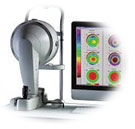
Keratoconus is detected usually on routine eye examination by the eye doctor. Keratoconus patient may have frequent change of glasses, presence of high cylindrical power (astigmatism) and also have increased habit of eye rubbing.
In advanced stage of keratoconus glasses do not help the patient to see clearly and they have to switch to using hard or semi-soft contact lenses to see clearly.
Eye specialist can diagnose early stage of keratoconus after a detailed eye examination which includes retinoscopy, slit lamp examination and specialized tests like topography to check the shape and curvature of cornea, pachymetry to determine the thickness of the cornea. Pentacam test is the gold standard for detecting early keratoconus.
What causes Keratoconus?
The exact cause of keratoconus is not known but latest research suggests that the cornea becomes weakened due to an imbalance of enzymes within the corneal tissue.
Keratoconus also shows some genetic predisposition. It may transmit from parent to children and affect morethan one family member. It is also associated with excessive eye rubbing as it is more common in allergic conjunctivitis patients who have itching and tend to rub their eyes more frequently.
Treatment options for keratoconus
In the early stages of keratoconus, corrective glasses or contact lenses can help the patient. As keratoconus advances, the corneal surface becomes increasingly irregular and these options do not help adequately. The treatment options for moderate to severe keratoconus are directed towards preventing the progression of keratoconus and for improvement in vision.
Avoiding eye rubbing is of utmost significance.
C3-R TREATMENT (Corneal Collagen Cross Linkage with Riboflavin)
It is a treatment which strengthens the inter-linkages between corneal collagen fibers. Eyedrops containing Riboflavin (Vit B2) are applied over cornea which is followed by ultraviolet light application.
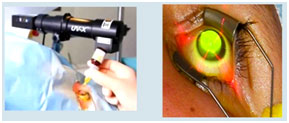
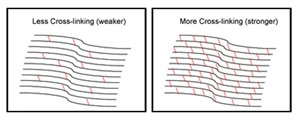
C3R treatment increases the interfibrillar collagen linkages causing strengthening of the cornea, preventing outward bulge and further progression of keratoconus. It is a US FDA approved treatment procedure for Progressive Keratoconus.
Newer Advances:
- Rapid/AcceleratedCrossLinking (KXL)
- CXL in thin cornea (a special Hypotonic Riboflavin dye is used for corneas thinner than 400 µ)
For visual rehabilitation, we have options like glasses, contact lenses, INTACS, PRK, ICL.
Contact lenses with good fitting help regularise the irregular conical cornea and eliminate aberrations, improving vision and its quality.

Special contact lenses like Rigid gas permeable lens (RGP), multicurved ROSE K lens are most effective.
They are the treatment of choice when glasses fail to help the patient. They provide a smooth refractive surface replacing the irregular cone like surface of the cornea, thus enabling the patient to see clearly.
Larger diameter minisclerallens( 14-16 mm ) and boston scleral lens ( 18-24 mm) provide good vision even with advanced cones and can be worn for longer hours.
INTACS
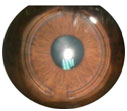
Intacs is a procedure which involves implanting one or two, tiny, clear crescent-shaped implants of a special polymer into a channel created within the cornea with a femtosecond laser. Intacs help to improve vision in patients with keratoconus by flattening the cornea.
Suitability
Intacs is ideal for adults over twenty one years of age, who suffer from keratoconus. The intacs prescription inserts are advised for patients to correct myopia and astigmatism when contact lenses are notsuitable.
Benefits
- Simple outpatient procedure
- Improvement in vision
- Reversible and exchangeable
- Minimally invasive as compared to corneal transplantation
- Can be combined with C3R in the same sitting
Advanced Surface Laser Treatment (Photo Refractive Keratectomy)
Can be combined with C3R for visual improvement in mild KC. It also helps to regularise irregular corneal curvature.
Implantable Phakic Lens For High Myopia And Astigmatism
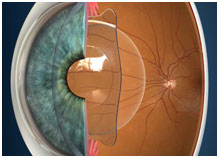
A collamer lens is permenently implanted in the eye of patients with stable Keratococnus and high myopia for improving vision and reducing the dependence on glasses and contact lenses
Corneal Transplant for severe keratoconus to get optimum useful vision.
- DALK: Deep Anterior Lamellar Keratoplasty: Partial thickness corneal transplant: It is a procedure of transplanting only the upper few layers of cornea.It has the advantage of faster visual recovery and least risk of rejection

- FULL THICKNESS CORNEAL TRANSPLANT (PK): Is done in cases of Severe Keratoconus with opacity.In this procedure the whole cornea (transparent outer covering of the eye) is replaced by a full thickness donor cornea. It needs regular follow-up after surgery.
Tags: causes of Keratoconus, CORNEAL TRANSPLANT, Keratoconus Treatment In Mumbai, Treatment options for keratoconusContact lenses
Read My All Blogs https://www.ojaseyehospital.com/blog



